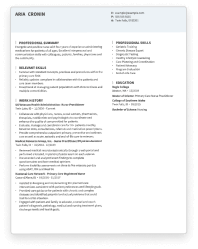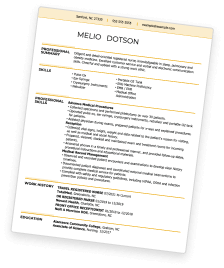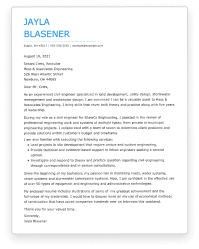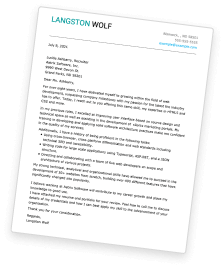Statistics Resumes: Overview
As a professional in statistics, you are tasked to perform the vital job of extracting meaningful insights from data to drive informed decision-making across various industries.
There are many titles of job titles to be found in statistics, including:
- Statistician
- Statistical Programmer
- Data Scientist
- Business Intelligence Analyst
- Market Research Analyst
Alongside a bachelor’s or master’s degree and a solid foundation in mathematics, you will need proficiency in statistical software, analytical prowess, strong problem-solving skills, and the ability to communicate your findings to team members and other stakeholders clearly.
Showcase these qualifications by writing a high-quality resume. Use our professional resume examples for inspiration, and browse our library of downloadable resume templates to find an option that fits your needs!
Statistics Resume Example: Consulting Data Analyst
This example of a statistical data analyst resume demonstrates the importance of making sound design and content choices to ensure your document grabs attention. Here are four of its best features:
-
Highlighted Soft Skills:
Industry-specific technical skills are balanced with soft skills and interpersonal attributes like “attention to detail” and “conflict resolution,” giving the candidate a holistic appeal.
-
Strategic Use of Color:
Subtle touches of color draw attention to the candidate’s name and help to distinguish resume sections without overwhelming the reader.
-
Clear and Concise Summary:
A professional summary at the top of the resume prefaces the rest of the content by succinctly highlighting the candidate’s strong points and areas of expertise.
-
Appropriate Length:
The resume effectively presents relevant information without including any unnecessary details, thereby adhering to the ideal length of one page.
Statistics Resume Example: Statistician
With a clean, simple design and carefully chosen content, this entry-level statistician resume example offers more insights for how to improve your own document. It’s a convenient reference if you are a recent graduate or have gaps in employment and want to emphasize skills over experience.
-
Numerical Evidence:
The candidate backs up their research, data analysis, and visualization skills by listing achievements and incorporating numerical metrics such as percentages to show impact.
-
Striking Header:
A colorful header helps to ground the document and introduce visual interest, making the resume stand out in a pile of more traditional black-and-white submissions.
-
Active Language:
Impactful action verbs like “evaluated,” “analyzed,” and “updated” make the resume more dynamic and show proactiveness.
-
Adequate Spacing:
A decent amount of space between resume sections and around the text prevents the document from looking cluttered and improves the reading experience for potential employers.
How To Write A Resume For Statistics Professionals
To build a strong statistics resume, you must select the right format and ensure each section effectively communicates your skills and experience. This guide offers the insight you need to create a strong resume outline and craft a document that communicates your expertise and aligns with industry expectations. Learn more about these specifics in our detailed resume-writing guide, highlighting some key considerations below.
Pick a Format:
There are three types of resume formats to choose from and it’s important to select the option that best aligns with your experience and career goals.
The chronological format focuses on work history and is ideal for statistics professionals who have followed traditional career paths and have more than 10 years of steady experience.
The functional resume, on the other hand, places emphasis on skills and education rather than experience, making it most suitable for job seekers with gaps in employment or career changers looking to transition to the field of statistics.
The third option, the combination resume, blends the chronological and functional formats, allowing you to highlight skills and training while also detailing your work history in a more traditional way. It’s a good resume option for statistics students and recent graduates, career changers, and those with under 10 years of experience.
Contact Information:
Design a header at the top of your resume and include your full name, phone number, professional email address, and location (city and state). If you have a well-maintained LinkedIn profile that complements your resume, consider including the link here too.
Ensure that your contact information is easily accessible and free of errors so that hiring managers have no trouble getting in touch with you.
Resume Summary or Objective:
Write a concise summary or objective statement that outlines how your skills and qualifications align with the position.
A resume summary is best for experienced statistics professionals. It should provide a brief overview of your professional background, with a focus on your statistical expertise, key accomplishments, and the value you can bring to an employer.
In contrast, a resume objective is more appropriate for entry-level candidates, recent graduates, and career changers. Like a summary, it highlights what you can bring to the table, but also mentions your career goals and what you hope to achieve in the role.
Both statements should be no longer than three or four sentences.
Work History:
Give potential employers an account of your work experience, starting with your most recent job and working backward in reverse chronological order.
For each position, list:
- the name and location of the company
- your job title
- and the dates of your employment
Use bullet points to describe your responsibilities and accomplishments, with a focus on specific achievements and quantifiable results.
For example, mention percentage increases, cost savings, and time efficiency gains, and highlight how you applied your statistical skills to enhance data accuracy or improve decision-making speed.
These sorts of details emphasize your contributions and help employers understand your work’s tangible impact.
Skills:
Add a separate skills section featuring a bulleted list of both technical and soft skills relevant to the statistics position you’re pursuing.
Include proficiency in statistical software (for instance, SAS and Python) and data visualization tools, and emphasize any other key skills in your repertoire that are mentioned in the job description.
Remember to highlight your ability to interpret complex data and effectively communicate findings. Use short phrases and bullet points so that readers can get a quick overview of your competencies in one scan.
Education:
Showcase your academic prowess by offering insight into your educational journey as it relates to statistics.
For each academic entry, state the degree earned, your major (if relevant to the job), and the name of the institution you attended.
You might also want to include your graduation date and any notable honors, certifications, and short courses relevant to the position.
If you’re a recent graduate or have limited work experience, consider placing your education section higher up in your resume and adding extra details about relevant academic achievements and projects.
Additional Sections (optional):
If it strengthens your application, you can include additional sections over and above the five standard resume sections outlined above. For example, you might want to add a section for relevant certifications, languages you’re proficient in, awards you’ve won, or significant statistical projects you’ve worked on.
Key Skills For Statistics Resumes
If your resume showcases sought-after statistics skills and certifications, you can greatly increase your chances of being considered for your target job. Learn more about in-demand hard skills, technical skills, and soft skills for statistics professionals.
Incorporating these credentials, interpersonal attributes, computer skills, and statistical competencies in your resume is a surefire way to pique the interest of hiring managers.
Top 5 Hard Skills for Statistics Resumes:
- Statistical Software Proficiency: Expertise in statistical software, programming languages, and business intelligence tools supports efficient data analysis and interpretation.
- Data Visualization: Proficiency in data visualization tools facilitates the presentation of complex statistical findings in a clear and compelling manner.
- Experimental Design: An understanding of experimental design principles is critical for planning and executing experiments to collect meaningful statistical data.
- Quantitative Analysis: The ability to apply statistical methods and techniques to number sets for analyses aids in solving real-world problems and making data-driven decisions.
- Machine Learning: Knowledge of machine learning algorithms and techniques ensures you can leverage advanced methodologies for predictive modeling.
Top 5 Soft Skills for Statistics Resumes:
- Analytical Thinking: The ability to think analytically enables you to approach complex problems methodically and derive actionable insights from data.
- Communication: Strong written and verbal communication skills are essential for effectively conveying statistical findings to both technical stakeholders and non-technical audiences.
- Attention to Detail: A detail-oriented approach ensures accuracy and precision in data collection, analysis, and interpretation.
- Problem-Solving: A talent for solving problems supports your ability to address challenges and use statistical methodologies to find innovative solutions.
- Collaboration: Good interpersonal skills and the ability to work well with others across functions facilitate success in a team-oriented environment.
Certifications For Statistic Professionals
Statistics professionals come with very specialized abilities, so certifications can help add credibility to a resume. Consider some of the most popular certifications below.
Top 5 Certifications for Statistics Resumes:
- Certified Business Analysis Professional (CBAP): This designation serves as proof of your business analysis knowledge and skills, increasing your marketability.
- Microsoft Certified: Power BI Data Analyst Associate: A reputable Microsoft certification, this credential showcases proficiency in preparing, modeling, analyzing, and visualizing data using Power BI.
- Certified Analytics Professional (CAP): The industry-leading CAP designation signifies that you have both the technical and soft skills to derive valuable insights from data.
- SAS Certified Statistical Business Analyst: Ideal for those looking to boost their credibility in statistics, this certification verifies your ability to perform statistical analyses and predictive modeling using SAS software.
- Certified Business Intelligence Professional (CBIP): Considered an industry standard, CBIP confirms your expertise and experience in analytics and data management.
Helping Job Seekers Like You
8 Tips For Writing A Statistics Resume
- Incorporate Keywords: Work keywords and phrases from the job description into your resume when describing your own abilities and experience. Doing so will help your resume pass an Applicant Tracking System (ATS) scan and show that you’re an exact match for the position.
- Highlight Relevant Software: Nowadays, statistics jobs rely heavily on using digital tools and technologies for success. Emphasize your familiarity with general statistical software, like R, Python, and SAS, and industry-specific programs to highlight your ability to use the modern tools of your trade confidently.
- Mention Specific Statistical Techniques: Avoid vague references to statistical methodologies and be as specific as possible when describing your proficient techniques. If you’re a master at regression analysis, hypothesis testing, and analysis of variance, be sure to say so in your resume while providing examples of how you’ve used these methods in the past.
- Quantify Your Impact: Using numbers to quantify your accomplishments, provide concrete evidence of your contributions in previous roles. Focus on highlighting how your statistical analyses directly impacted decision-making processes, leading to positive outcomes for past employers.
- Showcase Continuous Learning: Emphasize your commitment to lifelong learning by prominently featuring any certifications you’ve earned as evidence of your dedication to staying current in the field of statistics.
- Use a Clean, Contemporary Layout: Opt for a modern and polished format that reflects the precision and clarity associated with statistical analysis. If you plan to add a touch of color, use professional tones, such as shades of blue or green, to convey a sense of trust and expertise.
- Choose a Legible Font: Opt for a clear, familiar, and professional font typeface, such as Arial, Calibri, or Times New Roman. Use a font size that is easy to read – typically 11 or 12 points for body text and slightly larger for section headings.
- Create a Visual Hierarchy: Establish a visual hierarchy by bolding or italicizing section headings, job titles, and degree names. This draws attention to key information and helps guide the reader’s eye through your resume content in a logical, structured manner.


Save Time With Hloom's Resume Builder
Key Takeaways
- Hit all the marks by choosing the right format for your statistics resume and ensuring it includes the five standard resume sections: contact information, summary or objective, work history, skills, and education.
- Highlight your proficiency in statistical software programs and industry-relevant tools to demonstrate your technical expertise.
- Emphasize key soft skills like analytical thinking, communication, and attention to detail to present a holistic view of your capabilities.
- Showcase your commitment to ongoing professional development in the statistics field by listing relevant certifications you’ve earned.
- Use a clean, modern resume design, with adequate spacing, a professional font, and strategic use of color, to convey expertise and achieve a polished appearance.
Save Time With Hloom's Cover Letter Builder









